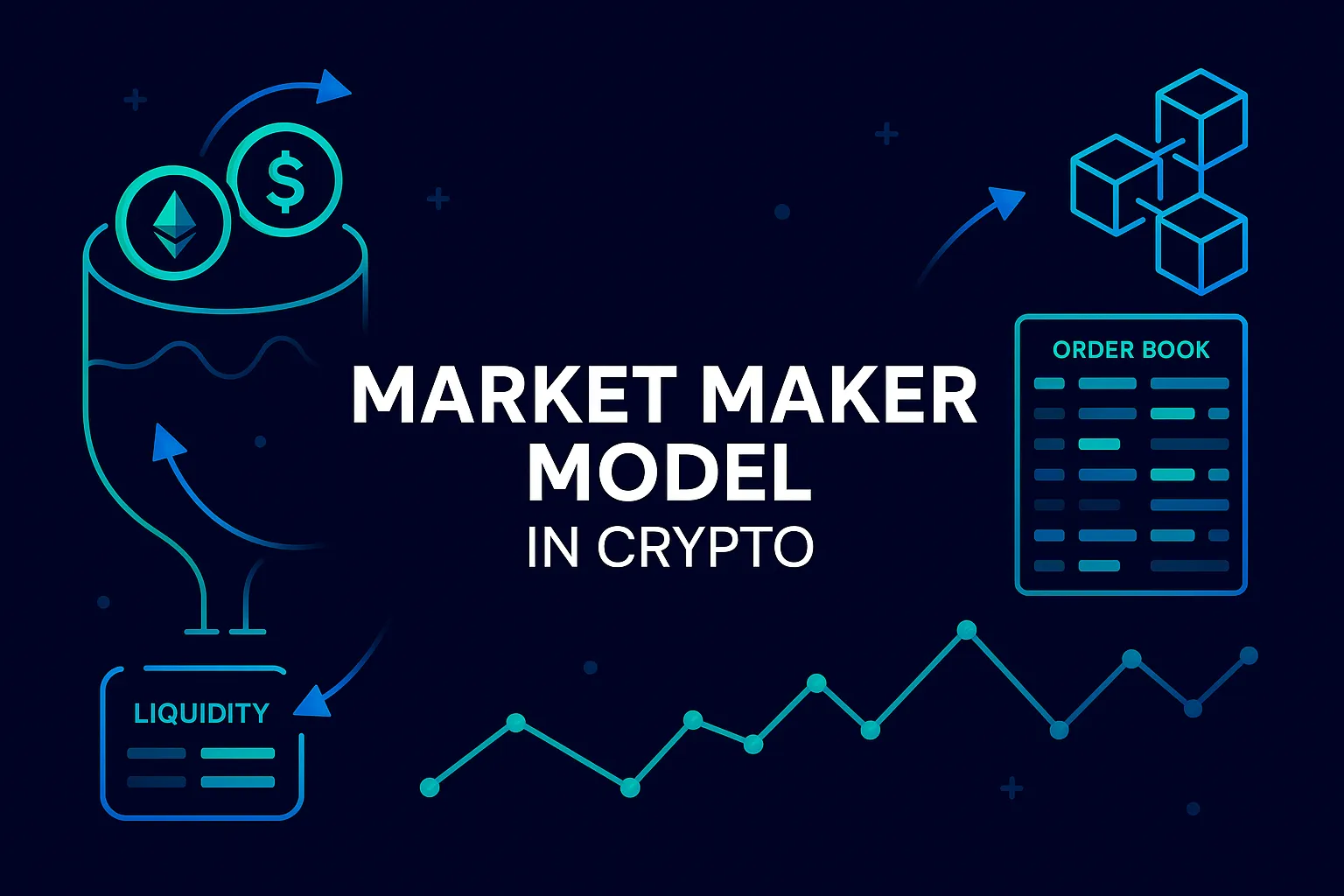Market Maker Model in Crypto: How DeFi Liquidity Works
How the Market Maker Model Fuels Crypto Trading and DeFi Liquidity
Table of Contents
- Introduction
- What Is a Market Maker Model?
- The Shift From Legacy to Crypto Market Making
- How Automated Market Makers (AMMs) Transformed Everything
- Order Books vs AMMs: Two Liquidity Visions
- Dynamic and Decentralized Models: The Future Frontier
- Why Market Maker Models Are More Important Than Ever
- Key Takeaways: The History of Crypto Liquidity
- FAQ
Introduction
The cryptocurrency market functions on the basis of billions of dollars’ worth of transactions per minute. All the wild hustle is fueled by a very important player keeping everything in working order: market makers. Their equipment are advanced models designed to function without a glitch, particularly in decentralized finance (DeFi).
What Is a Market Maker Model?
A market maker design is a structure that offers continuous buying and selling of a specific asset. Traditionally, market makers have offered bid and ask prices and profit on the difference (the spread). In cryptocurrency, however, that dynamic has been reversed entirely due to advances in decentralization. DeFi exploits autonomous systems based on smart contracts that eliminate the requirement for human intercessions. Instead of simply posting static prices, innovative market-making architecture calculates prices and dynamically levels off liquidity pools, and pushes transaction charges.
The Shift From Legacy to Crypto Market Making
In traditional finance, institutional players controlled market-making roles. They would look at order books, forecast price behavior, and modify bids and offers in response. Centralized Exchanges (CEXes) later mechanized these functions, allowing one to trade faster through electronic interfaces. DeFi broke away dramatically from this model. Rather than relying on central matching engines, users began to engage with pools of liquidity managed by algorithms. Humans were less involved, and intelligent models became essential.
How Automated Market Makers (AMMs) Transformed Everything
Uniswap introduced the world’s first true Automated Market Maker (AMM) in crypto. AMMs do not match and pair one-on-one buyers and sellers as in traditional market-making. They instead allow participants to exchange tokens directly with one another using pre-determined formulae that are placed in smart contracts.
One of the earliest ideas in AMMs is the Constant Product Formula (x*y=k), which approximates prices based on relative quantities of two assets in a pool. Everybody was made a liquidity provider (LP), proportionally rewarded.
Later AMM implementations introduced more flexibility and efficiency:
- Curve Finance: Simplified design for low-volatility stablecoin pairs.
- Balancer Labs: Introduced flexible weight settings.
- Uniswap V3: Authorized concentrated provision of liquidity, with LPs targeting narrower price ranges.
Order Books vs AMMs: Two Liquidity Visions
Despite the AMM revolution, order book models never went away — especially for high-volume trading. Exchanges like dYdX and Injective now run on-chain order books, delivering the precision traders expect while keeping settlement decentralized.
Here’s the basic contrast:
| Feature | AMM | Order Book |
|---|---|---|
| Speed to market | Instant liquidity | Deep price control |
| Risk | Impermanent loss | Front-running bots |
| Flexibility | Passive LPing | Active market making |
| Ideal for | Low-liquidity assets, DeFi | High-frequency trading, Pro traders |
The choice between AMMs and order books is less about right or wrong — it’s about matching model architecture to the use case.
In reality, crypto is heading toward hybrid models that blend both approaches, adapting to market conditions dynamically.
Dynamic and Decentralized Models: The Next Frontier
Shifting dynamics call for resilience. New market-maker models need to cope with new market dynamics in real time. Hybrid models such as AMM–order book hybrids, for instance, aim to solve the scalability challenges posed by natively deployed AMMs.
Some other developments include:
- Layer-2 Solutions: Enhancing speed at the cost of gas expenses.
- Flash Loans: Enabling arbitrage windows of limited duration.
- Advanced Risk Management Tools: Fending off LP positions away from impermanent loss.
All these innovations represent the fast-moving nature of development in the realm of crypto liquidity management.
Why Market Maker Models Are More Important Than Ever
Market maker models are essential since they introduce order into the market when the market is running erratically. Without them, markets will be chaotic, with enormous spreads and illiquidity characterizing trades. By removing price imbalances and allowing smooth trades to be made, the models facilitate easier increased participation in crypto ecosystems.
They also allow smaller participants to compete on an equal footing with legacy institutions. In addition, with increased regulatory clarity across the globe, more optimally designed market-making architectures will become palatable, driving mass adoption of crypto-assets.
Key Takeaways: The Future of Crypto Liquidity
- Multi-Faceted Choices: There are side-by-side order-book and AMM-based paradigms, each serving a distinct purpose.
- Endless Improvements: Iteration after iteration delivers incremental improvement over the last models, filling the gaps, and providing an enhanced user experience.
- Regulatory Harmony: Models of good governance are needed for wholesome development.
- Global Accessibility: Market-making models democratize liquidity access to the benefit of retail investors globally.
FAQ
Can I Be a Liquidity Provider?
Absolutely! You can invest in liquidity pools through sites such as Uniswap and others, receiving commissions on trades made through said pools.
Are There Any Risks Involved in Being a Liquidity Provider?
Yes, there is risk involved, particularly impermanent loss when values are wildly different from initial deposits. Risk analysis should be done with caution before getting involved.
Are All Cryptocurrency Markets Based on Market-Making Models?
No, some specialist markets may be unique, but market-making principles apply to the majority of exchanges and DeFi protocols.
Post created by Robert AI Team




